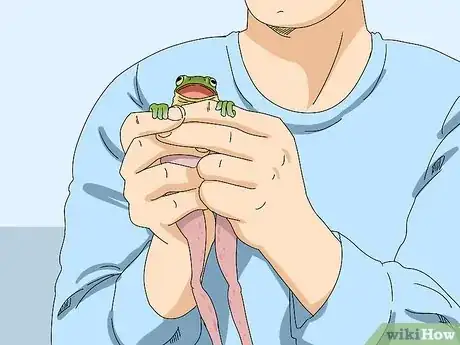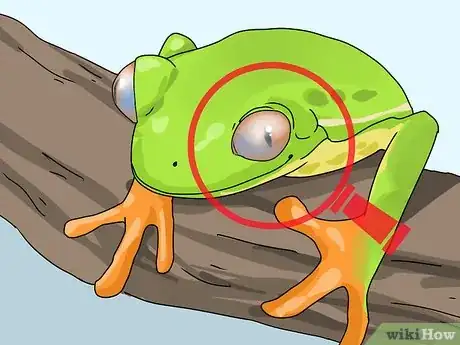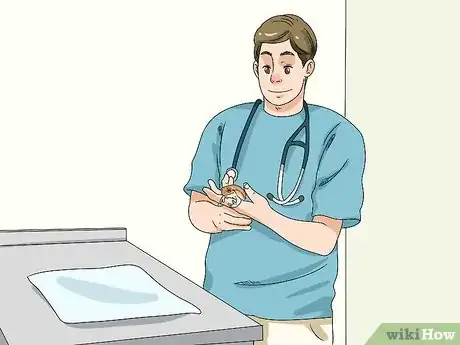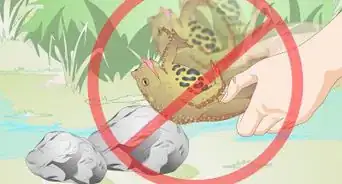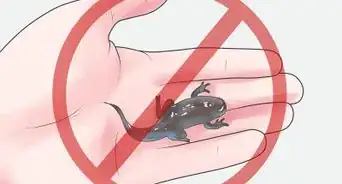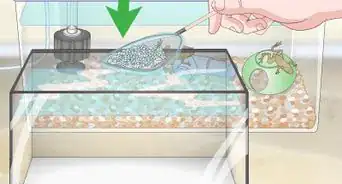This article was co-authored by Deanne Pawlisch, CVT, MA. Deanne Pawlisch is a Certified Veterinary Technician, who does corporate training for veterinary practices and has taught at the NAVTA-approved Veterinary Assistant Program at the Harper College in Illinois and in 2011 was elected to the board of the Veterinary Emergency and Critical Care Foundation. Deanne has been a Board Member of the Veterinary Emergency and Critical Care Foundation in San Antonio, Texas since 2011. She holds a BS in Anthropology from Loyola University and an MA in Anthropology from Northern Illinois University.
There are 8 references cited in this article, which can be found at the bottom of the page.
This article has been viewed 213,808 times.
Tree frogs can be great pets that are generally easy to care for. However, they can develop a variety of illnesses, and it can be a bit of a challenge to figure out exactly what they have. It is a good idea to know the general signs of illness in tree frogs so that you will be able to spot common diseases. It's also important to know when it is time to get professional help from a veterinarian so that your frog can live a long and healthy life. The best way to prevent your frog from developing illnesses is to make sure you're giving it the proper care it needs.[1]
Steps
Noticing Obvious Changes
-
1Check for discoloration. There are a variety of illnesses that can cause a tree frog to become discolored. Red-Leg, a common disease in pet tree frogs, causes the skin near the frog's legs to turn reddish. Sometimes something as simple as lack of humidity, stress, or a poor diet can cause a frog to have darkened skin.[2]
- If your frog's skin is dry in addition to being discolored, this can be caused by a combination of stress and dehydration.
- However, some tree frogs naturally have a bit of red pigment on their legs. Keep track of your frog's coloring so that you can tell when it changes.
- If your frog is discolored, you should have it seen by a veterinarian.
-
2Assess your frog's energy level. Lethargy can be a key symptom of a variety of illnesses that occur in tree frogs. They include Red-Leg, MBD, edema, and others. Look for a lack of activity, the frog's jaw to hang open, and its legs to be sprawled out.[3]
- Red-Leg is often fatal — there is no known cure for it.
- MBD is usually curable if it is treated right away. MBD usually makes the frog stop eating and jumping. This is due to improper feeding, which causes a lack of vitamin D and calcium.
- Edema is when the frog swells up and becomes lethargic because it is so bloated. If your frog is lethargic and not bloated, then it does not have edema.
Advertisement -
3Look for bloating. If your frog has swollen up, it is most likely caused by edema. There are actually two types of edema. One is a bacterial infection and the other is from kidney failure due to vitamin toxicity. If it is the bacterial kind, you should soak your frog in clean spring water for a few hours to clear out the infection. The frog should be alright after that. Unfortunately, if your frog has edema caused by kidney failure, it will most likely die from the condition.[4]
- Since bacterial edema can be cleared up relatively easily at home and the one caused by kidney failure is always fatal, it is up to you whether to take your frog in to be seen by a vet.
- To prevent edema, clean your frog's cage weekly and change its water frequently.
- Dying from kidney failure can be a slow, painful process. If your frog has edema caused by kidney failure, humane euthanasia performed by your vet is an option.
-
4Consider trouble with eating. Changes in your frog's appetite can signal a problem with their digestive system or an illness that does not allow them to catch their prey. For example, lack of appetite is a symptom of MBD. This disease weakens the bones of your frog and decreases its energy so much that it can't chase down its prey. MBD is often caused by improper feeding. Trouble with eating could also be the result of a parasite.
- If you have more than one frog housed in the terrarium, some frogs could be getting more food than others.
- You should also make sure you are feeding your frogs small crickets, because medium and large ones are too big for a tree frog to swallow.
-
5Pay attention to changes in your frog's sleeping habits. Your frog may be ill if it is awake during the day. Lack of sleep can occur when the frog is stressed out, such as right after you bring it home. However, it can also be a symptom of diseases that make the animal uncomfortable, such as edema.[5]
Looking for More Signs of Illness
-
1Look for sores, cuts, and bruises. Damage on the frog's skin when you first get it is probably due to being banged around while in transit. However, if the injury doesn't heal in a few days the damage could be the result of a bacterial infection. If it doesn't heal over the course of a week or so, the frog needs to be taken care of by a vet.[6]
- If not treated, these infections and wounds can let harmful bacteria into your frog's body. This can result in death.
- Sores and bruises, as well as cuts, can cause a frog's skin to look strange.
-
2Inspect your frog's eyes. If your frog's eyes are smoky, cloudy, foggy, or blueish, it most likely has a condition known as Cloudy Eye. This occurs when the eye is bashed, poked, or scratched.[7]
- If your frog's eyes are cloudy, you should get it veterinary care.
-
3Monitor your tree frog's weight. If your frog has lost weight, it may have either an internal parasite or Metabolic Bone Disease (MBD). A vet can cure both MBD and a parasitic infection, so take your frog to be seen by a vet if it has lost weight. If your frog has gained weight, this is probably due to overfeeding, or it could be a sign of edema. Cut back on the amount of food it gets and make sure its weight stabilizes by weighing it every few days.[8]
- If your frog is losing weight, it could be that your frog is just naturally thin or that it needs to be fed more.
- You will need a digital scale to weigh your tree frog. Set a container with a lid on it on your scale and zero it out. Then put the frog in the container and read the screen. If you plan on documenting the frog's weight over time, be sure to write down its weight every time you weigh it.
Getting a Veterinary Diagnosis
-
1Find a vet that is experienced with treating tree frogs. To find a vet that works with frogs, contact local veterinary schools or look online for lists of veterinarians that work with amphibians. For example, you can look at the website of the Association of Reptilian and Amphibian Veterinarians.
- If there are several vets in your area who work with amphibians, make sure the vet you choose is the one that has the most experience with tree frogs.
- It's a good idea to find a vet before your frog is actually sick. Having an established relationship with a veterinarian that treats tree frogs will make it easier to get your pet quick care when it needs it.
-
2Take your frog in for an examination. It is best to have your frog checked out by a veterinarian if you see a symptom of illness. While you may end up bringing your pet in for a problem that is non-existent, it is better to be safe than sorry. Some diseases require quick treatment in order to be eliminated.
- If you suspect that your tree frog is sick but you are unsure about bringing it in to be seen by a vet, at least call the veterinary office and talk to them. Tell them about your pet's symptoms and ask them if they think your frog needs treatment.
-
3Follow your veterinarian's suggestions for treatment. If your tree frog is indeed ill, your veterinarian will begin its treatment and will give you instructions on how to continue treatment at home. Follow these directions and be sure to continue treatment for as long as your veterinarian suggests, even if your tree frog seems completely healed.
- If treatment is not minimizing your frog's symptoms or they are getting worse, contact your vet once again. It may be that your frog needs a different type or amount of treatment.
Warnings
- See a vet right away if you think anything may be wrong with your frog. It is a good idea to have a potential illness checked out by a professional in case the problem is severe and could threaten your pet's life.⧼thumbs_response⧽
References
- ↑ http://www.redeyedtreefrog.org/how-to-recognize-illness-in-red-eyed-tree-frog/
- ↑ http://azeah.com/frogs/basic-care-whites-tree-frog
- ↑ http://www.peteducation.com/article.cfm?c=17+1848&aid=2467
- ↑ https://www.ncbi.nlm.nih.gov/pubmed/16931378
- ↑ http://www.frogdaze.com/tree-frogs.html
- ↑ http://www.frogdaze.com/the-frog-doctor.html
- ↑ http://www.redeyedtreefrog.org/how-to-recognize-illness-in-red-eyed-tree-frog/
- ↑ https://www.petco.com/content/petco/PetcoStore/en_US/pet-services/resource-center/caresheets/tree-frogs.html
- ↑ http://www.merckvetmanual.com/exotic-and-laboratory-animals/amphibians/noninfectious-disorders-of-amphibians
About This Article
If you think your tree frog is sick, pay attention to its skin color and general behavior to diagnose its illness. For instance, if the skin near your frog’s legs turns a reddish color, your frog may have a disease called Red-Leg. Unfortunately, there’s no cure for this disease. If you notice that your frog is lethargic, like not jumping or its jaw hanging open, and it looks swollen, it could be suffering from edema. Try soaking your frog in clean spring water to see if that helps. Keep reading to tips from our Veterinary co-author to learn signs of a bacterial infection on your frog’s skin!

